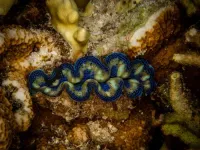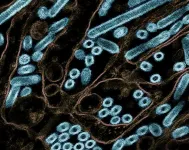(Press-News.org) CRISPR-Cas9 has long been likened to a kind of genetic scissors, thanks to its ability to snip out any desired section of DNA with elegant precision.
But it turns out that CRISPR systems have more than one strategy in their toolkit. A mechanism originally discovered in bacteria, where it has operated as an adaptive immune system for eons, CRISPR is naturally deployed by certain singled-cell organisms to protect themselves against viruses (called phages) and other foreign genetic fragments. Now, researchers at Rockefeller’s Laboratory of Bacteriology headed by Luciano Marraffini, and at the MSKCC’s Structural Biology Laboratory headed by Dinshaw Patel, have discovered how one CRISPR system battles invaders with not only genetic scissors but also acts as a sort of molecular fumigator. In a recent publication in Cell, the scientists found that this system, called CRISPR-Cas10, floods a virally infected bacterium with toxic molecules, and thus prevents the virus from spreading through the rest of the bacterial population.
“It’s a completely brand-new type of CRISPR chemistry,” says co-first author Christian Baca, a TPCB graduate student in the Marraffini lab. “It’s more evidence that CRISPR systems have an array of immune strategies at their disposal.”
Cell shutdown
There are six types of CRISPR (“clustered regularly interspaced short palindromic repeats”) systems; CRISPR-Cas9, for example, is type II, with the enzyme Cas9 functioning as the DNA scissors. For the current study, the researchers looked at a type III system called CRISPR-Cas10.
In both systems, guide RNAs identify problematic genetic material, and the enzymes begin snipping. However, the CRISPR-Cas10 complex also produces a burst of small second messenger molecules called cyclic-oligoadenylates (cOAs), which helps shut down cell activity, thereby preventing the virus from spreading. This second line of attack is akin to fumigating one pest-ridden room, and then quickly shutting the door to keep the infestation contained so it can’t spread to the rest of the house.
This two-part response is largely a matter of timing, says Baca. “Cas10 alone can clear a phage or plasmid from a cell as long as the target transcript that’s been recognized by the guide RNA is made early in the viral infection. But if the problematic snippet is something only made at a later stage of the infection, these cOA molecules are essential for defense,” he says. “In this way, type III CRISPR systems work similarly to mammalian innate immunity pathways, such as cGAS-STING, that produce cyclic nucleotides to activate a host response,” adds Marraffini.
While that much was known, the molecular dynamics behind how, exactly, a new Type III CRISPR protein, CRISPR-associated adenosine deaminase 1 (Cad1) achieves cell shut down was not.
A toxic plume
To find out, the researchers undertook a detailed molecular and structural analysis of Cad1, using cryo-EM and other advanced approaches to reveal unusual structures and dynamics that explain how the system pauses cell activity.
In the CRISPR-Cas10 system, Cad1 is alerted to the presence of a virus by the binding of cOAs to a part of the protein called the CARF domain. That in turn stimulates Cad1 to convert ATP (the energy currency of the cell) into ITP (an intermediary nucleotide that usually is present in the cell in small amounts), which then floods the cell. ITP turns toxic to cells in high doses, so as a result, cellular activity comes to a halt, putting the cell in a dormant state.
“The infected cell is sacrificed when the virus is sequestered within it, but the larger bacterial population is protected,” says co-first author Puja Majumder, a postdoctoral research scholar at the Patel Lab. Why it has this impact is unclear. One theory is that excess ITP competes for binding sites typically occupied by ATP or GTP in proteins that are critical for normal cellular function; another is that high levels of ITP interfere with phage DNA replication.
“But we don’t really know why yet,” Majumder says.
One potential application of their discovery is as a diagnostic tool for infection, Baca notes. “The presence of ITP would indicate that a pathogen transcript is present in a sample.”
END
A new chemistry for CRISPR
2024-10-28
ELSE PRESS RELEASES FROM THIS DATE:
Giant clam declared critically endangered after the latest assessment
2024-10-28
The giant clam, known for its colorful cape-like mantle, wavy shell and astonishing size, is in danger of going extinct after its population plunged by more than 80% over the last century, according to a new assessment by a University of Colorado Boulder biologist and collaborators.
The assessment, led by Ruiqi Li, a postdoctoral researcher at the CU Museum of Natural History, prompted the International Union for Conservation of Nature (IUCN) today to update the conservation status of this animal from “vulnerable” to ...
DOE awards $12 million to expand marine energy initiatives at Lehigh and partner universities
2024-10-28
The U.S. Department of Energy (DOE) recently granted the Atlantic Marine Energy Center (AMEC) $12 million to expand research and development in marine energy initiatives. AMEC comprises four universities including the University of New Hampshire, Stony Brook University, the Coastal Studies Institute, and Lehigh University.
In total, DOE’s Water Power Technologies Office invested more than $41 million in this latest round of funding using the Bipartisan Infrastructure Law (BIL) to four university-led National Marine Energy Centers located across the country. The centers will use the funds to support research, infrastructure improvements, strategy, administration, outreach, ...
Pythons can swallow even bigger prey than scientists realized
2024-10-28
Burmese pythons can consume prey even larger than scientists realized, according to a new study.
That means more animals are on the menu across southern Florida, where the nonnative, invasive snakes have decimated populations of foxes, bobcats, raccoons and other animals.
Pythons swallow deer, alligators and other prey whole. What they eat is limited in part by how big an animal they can wrap their flexible, stretchy jaws around. Researchers call this the snake’s gape.
University of Cincinnati Professor Bruce Jayne said measurements of snakes captured in and around Everglades National Park show that the biggest pythons have an even bigger gape than mathematical ...
Evidence mounts for dark energy from black holes
2024-10-28
Image
Almost 14 billion years ago, at the very beginning of the Big Bang, a mysterious energy drove an exponential expansion of the infant universe and produced all known matter, according to the prevailing inflationary universe theory.
That ancient energy shared key features of the current universe's dark energy, which is the largest mystery of our time by at least one objective standard: It makes up the majority—roughly 70%—of the universe, but scientists ...
AI might scare us, but can we scare it?
2024-10-28
In recent years, advancements in artificial intelligence have enabled intelligent machines to generate visual art, compose music, and create videos. They converse with us, help with homework, and have even begun competing for our jobs. Amid these advances, machines evoke powerful reactions from humans—sparking concerns about control, fairness, and the potential for misuse. Many feel unsettled by the growing presence of intelligent machines when they inadvertently reinforce power imbalances and perpetuate injustices.
Amid all of this disruption and mistrust, we are comforted to know that machines can`t have emotions. Yet, recent advancements in language-based AI have demonstrated ...
Early intervention in patients with asymptomatic severe aortic stenosis and myocardial fibrosis
2024-10-28
About The Study: In asymptomatic patients with severe aortic stenosis and myocardial fibrosis, early aortic valve intervention had no demonstrable effect on all-cause death or unplanned aortic stenosis–related hospitalization. The trial had a wide 95% CI around the primary end point, with further research needed to confirm these findings.
Corresponding Author: To contact the corresponding author, Marc R. Dweck, PhD, email marc.dweck@ed.ac.uk.
To access the embargoed study: Visit our For ...
Rutgers receives $3.3 million federal grant to recruit counselors for high-need schools
2024-10-28
Rutgers University’s Graduate School of Education (GSE) has received a $3.3 million grant to increase the number and diversity of highly trained school counselors to help fill the gap in mental health services in New Jersey high-need school districts.
The Mental Health Service Professional Demonstration grant from the U.S. Department of Education – part of a federal initiative to expand nationwide student access to school-based mental health services – will fund the GSE-led School Counseling Prevention to Intervention project.
“School counseling is often a misunderstood and under-resourced profession,” said Ian Levy, an assistant professor of school counseling ...
Bovine H5N1 influenza from infected worker transmissible and lethal in animal models
2024-10-28
WHAT:
A highly pathogenic avian influenza (HPAI) H5N1 virus, isolated from the eye of a farm worker who became infected through contact with dairy cows, was lethal in mice and ferrets infected in a high-containment laboratory environment, according to a new study in Nature. The study investigators also found that the virus isolated from the worker, who experienced mild inflammation of the cornea (conjunctivitis), could be transmitted through the air between separated ferrets and might be capable of binding to and replicating in human respiratory tract cells.
The virus isolated from the worker is called huTX37-H5N1 and has a mutation (PB2-E627K) frequently seen in avian influenza viruses ...
Marzougui & Kan receive funding for crash testing
2024-10-28
Dhafer Marzougui, Associate Professor, Physics and Astronomy, College of Science, and Cing-Dao Kan, Professor/Director, Center for Collision Safety and Analysis, College of Science, received funding for: “NCHRP Project 03-110-01.”
Marzougui and Kan aim to identify and evaluate the crash performance of breakaway sign and luminaire supports and crashworthy work-zone traffic control devices that are non-proprietary and commonly used.
The researchers will examine in-service safety performance, potential failure modes (and, if possible, design modifications that might address ...
Global leaders in the fight against cancer gathered in Washington, DC on October 18, 2024, for the NFCR Global Summit and Award Ceremonies for Cancer Research & Entrepreneurship
2024-10-28
Washington, DC – The 2024 National Foundation for Cancer Research (NFCR) Global Summit and Award Ceremonies for Cancer Research & Entrepreneurship, co-hosted with the AIM-HI Accelerator Fund, convened the world’s top experts across cancer research, biotech entrepreneurship, pharmaceuticals, investment, and patient advocacy. This prestigious event, held at the National Press Club, served as a unique forum for advancing groundbreaking science, fostering innovative collaborations, identifying ...



